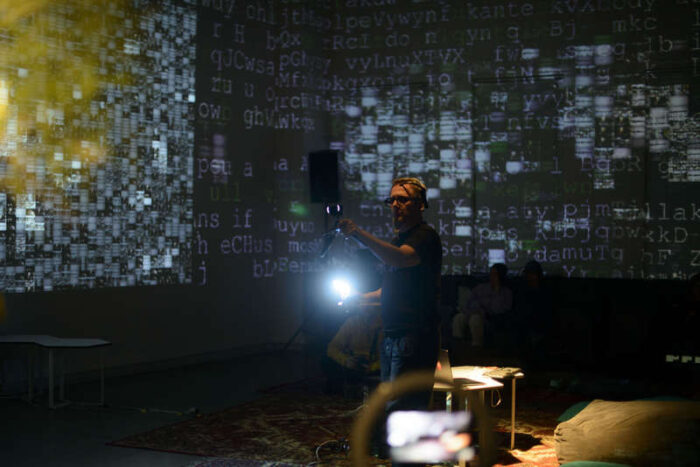KTO Theatre are presenting a series of ‘performances without words’, at their amazing new home in Podgórze.
As visual theatre, without dialogue, the performances will be a perfect choice for expats, tourists and anyone who would like to enjoy theatre in Krakow without a language barrier.
The Performances without Words February performances are:-
Chorus of Orphans
Thursday 10th & Friday 11th February
7pm
I’ll Sell the House In Which I Can Live No More
Saturday 12th December
7pm
Nameless/ Unknown
Friday 18th February
7pm
Black Satori
Thursday 24th February
7pm
Serena – a Treatise on Vowels
Friday 25th & Saturday 26th February
7pm
All performances will take place at:-
KTO Theatre, ul. Zamoyskiego 50, Kraków
Performances without words at the KTO Theatre present are unique on the local cultural map. They are based on universal communication with the use of body language and music creating a new space for Krakow’s physical theatre, dance theatre as well as theatre of movement and performing arts.
View the KTO Theatre Repertoire
Ticket Information
Chorus of Orphans
They all have the same clothes, heavy boots, rigid schoolbags and humble haircuts. They act synchronously and with great sensitivity. They do not sing, do not talk, do not smile at each other. Chorus of Orphans directed by Jerzy Zoń is a textless, hypnotic tale about loneliness. It lasts just as long as H.M. Gorecki’s Symphony No. 3 (known also as Symphony of Sorrowful Songs) which accompanies the actors from the beginning to the end, setting the rhythm of the entire performance, that is precisely 52 minutes and 6 seconds. This is how much was needed to demonstrate a cruel reality of life in an orphanage where the sense of togetherness gives way to infinite loneliness. Chorus of Orphans is a highly moving tale about helplessness and hopelessness, about trauma and drama of human life.
I’ll Sell the House In Which I Can Live No More
An hour-long theatrical séance inspired by the life and works Bohumil Hrabal. After 15 years of only open-air productions, it is Jerzy Zoń’s first stage production in the KTO Theatre. Since it’s premiere in 2003, it has been performed more than 530 times, becoming one of the audience favourites, not only in Krakow. The production has won the Buława Hetmańska Audience Award of the 40th Zamość Theatre Summer (Zamojskie Lato Teatralne). It is one of the most travelled KTO Theatre performances and it has been presented during dozens of tours, including Albania, Austria, Belarus, Croatia, Czech Republic, France, Georgia, Iran, Germany, Russia, Romania, Slovakia, Ukraine, USA and Great Britain.
Although it seems impossible to spin a tale of Hrabal without the least piece of dialogue, Teatr KTO faultlessly translate the magic of what’s been told into bodily expression, into a kaleidoscope of faces and gestures sprinkled with vodka, to the grand baptism accompanied by accordion, to the joy and sadness contained in a quiet funereal sob. The lazy images pulse with music phenomenally selected by Jerzy Zoń – the director of both the theatre and the production. Anyone who loves Hrabal’s prose, who has wordlessly read more than one story told in the dialect of Prague, of the beerhall, for amateurs of Czech literature there remains a universal tale about human life, coloured with a touch of irony and the reflective song of a barrel-organist who is traveling from Mexico to Paris. Without doubt, Teatr KTO’s artists have created an enchanting production closely observed by music and silence. Aleksandra Czapla-Oslislo, Gazeta Wyborcza
Nameless/ Unknown
“Nameless/Unknown” is inspired by the series of books “The Wars of Adults; The Stories of Children”, graphic novel “Arrival” by Shaun Tan, “Wander of Nabu” by Jarosław Mikołajewski, reportage “Dzieci z dworca Brześć” [“Children from Brest station”] by Marina Hulia and Monika Głuska-Durenkamp and real emigrants memories. The project’s style crosses between puppet theatre, visual, physical theatre and aerial dance in order to convey challenging aspects of the modern migration.
The story circulates around migration’s causes, circumstances and characters – nameless heroes who were forced to abandon their homes. Authors are asking the questions: what can cause a person to let go of one’s current life and set out for another country? Why do they strive for the places, where there is no family and friends, where everything is nameless, unknown and the future is questionable? The stories, implemented into the dramaturgy of the play, unravel a search for a safe haven in the cruel world. In this world it’s frequently imperative to sacrifice all the possessions and the past, to win a chance at a future for oneself and one’s family. These stories touch the topic of solitude, foreignness and confusion of a person convicted to a new, forced reality – which at the same time is a refuge from doom.
The performance takes the form of a journey that the spectator embarks on along with the characters. Consecutive stories of the migrants are born into the world, unlocked from suitcases, told without words, to the accompaniment of the sounds and music, created live using instruments and everyday objects. This visual and physical theatre operates with a richness of sounds and images, influencing the imagination of the spectator and encouraging an autonomous interpretation of the performance, where everything is fluent, literally and figuratively – in constant movement. The spectator, boarding the ship – which is the core of the scenography – accompanies the characters in the venture to the place of their possible new home. This long and dangerous road is the only way to remedy the problems that afflicted them in their homeland. Nobody can be sure of the journey’s end.
Is it possible for them to feel the smell of the land? Receive help? Confront with the outland culture and language? Holding the travel ticket, spectators will decide about the course of the story and the chapters it will unfold.
BlackSatori
Alek Janicki’s audio-visual performance entitled BlackSatori binds picture and sound, allowing the audience to reach spheres inaccessible to intellectual speculation. It is an attempt at getting an insight into a meta-reality beyond a specific time, place and a paradox, which is a clue for interpretation, is hidden in the title of the piece itself.
BlackSatori – black enlightenment? It bears reference to the koans in the tradition of Zen, a method that triggers some practices aiming at reaching a path to enlightenment. Iconosphere and phonosphere constitute here a consolidated eco-system of a quasi-meditational spectacle. The piece, based on paradoxical, coincidental associations and subconsciously received impressions generated with a Big DADA Generator (images) and an EEG brain wave scanner (sound), strives at maximal simplicity and clarity of form, regardless of its complex instrumentarium.
Both in its audial and visual layers the piece is created in real time, ”here and now”, as an outcome of actions taken by the performer with the use of algorithms. The camera with which he produces a constantly changing inventory of images generates evolving pictures in which the performer and his audience are immersed. All elements of theatre space, including the performer and his viewers, turn into a screen.

”Serena – a Treatise on Vowels”
Is a theatrical installation inspired by ”The Little Mermaid” by H.C. Andersen, is a tale about crossing the borders of existence. Love intermingles here with the feeling of emptiness. Characters are put in extreme situations with no options of a simple choices. The title Mermaid (half woman and half fish) decides to totally deconstruct her world. She exceeds all boundaries of existence. Being aware of the possible consequences, both she and the Prince decide to yield to ultimate love. The performance is a sort of struggle between life and death, between being and not being, becoming thus an elegy on non-fulfilment.

A Scot in Kraków. The founder and editor of Kraków Expats Directory, and our sister sites Kraków TV and Kraków Stories Podcast.
David fell in love with Kraków 24 years ago, making it his home in 2011.
In 2020 he was awarded the title of Kraków’s Ambassador of Multiculturalism, by the President of Kraków, and is also a member of the GlobalScot network, representing Scottish culture and business abroad.
We’re always looking for interesting stories, events, characters or groups to feature. Likewise, if you’d like to join us, as a contributor, please get in touch.

